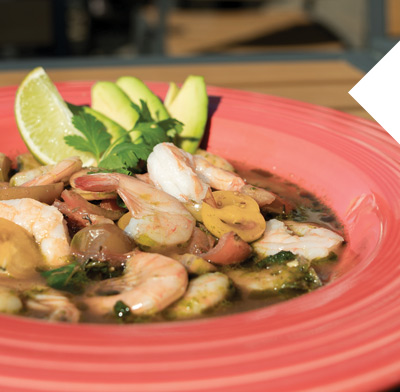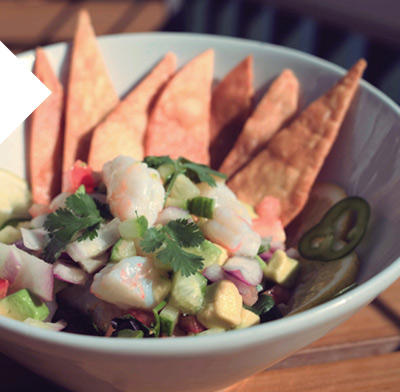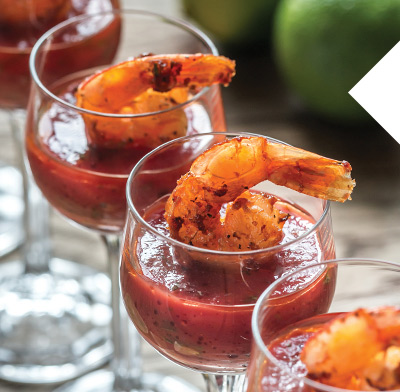After finishing my first season as a chef at Roche Harbor in 1993, I was asked by then Harbor Master Bart Mathews to work the Seattle Boat Show with him. As passersby stopped at our simple booth, I began to appreciate how much Roche Harbor means to the boating community. Flash forward 25 years to today, and my love for the resort, our guests, and the staff have made working at Roche far more than a job.
Spring in the San Juan Islands may signal the start of the boating season for most, but for Island fisherman and seafood chefs like me, it means the long-awaited spot prawn season is open. A true Northwest delicacy, these tender, buttery crustaceans are in my opinion the most flavorful shrimp you will ever eat. The most common method of cooking spot prawns is to boil them whole in salted water, then peel them and dip the tails in cocktail sauce or warm butter. This classic method is an amazing experience, but they can be so much more. Here I include a few of my favorite shrimp recipes that can be made with shrimp from your local market, but if you are able to get a hold of some fresh spot prawns you will be hooked.
When fishing for spot prawns or getting them from a local fisherman, it best to get them live and hold them on ice until ready to serve. Spot prawns will only live a few hours, and for the best tasting prawns the heads should be removed. After the heads are removed, they can be held for a couple days on ice in the refrigerator or frozen in a container filled with a saline solution (1 teaspoon salt to 1½ cups water). The prawns will last 6 to 12 months frozen.
When local sources aren’t available, buying shrimp and prawns can be confusing as there are many different types of shrimp available in today’s market. Look for wild Mexican white or brown shrimp from the Pacific or the Gulf of Mexico. They are simply the best alternative. If you cannot get wild, farmraised tiger shrimp are a good substitute. Also buy the largest shrimp you can find, the sizing of shrimp is based on the count per pound. A common large size is a 16 to 20 or an average of 18 shrimp per pound. I use the U-8 size or less than eight per pound, these two-ounce shrimp are very impressive on the plate.

|
Spot Prawn and Avocado Soup
This simple recipe can be an appetizer to a larger meal or an entrée. Pacific spot prawns are an excellent choice for this soup because of their intense buttery flavor and soft lobster-like texture. In a saucepan, bring the shrimp stock to a boil and add Thai red curry paste. Stir shrimp stock until curry paste is dissolved. Reduce heat to simmer. Meanwhile, prepare the avocado, tomato, cilantro and chilies. Choose a wide-rim bowl for this soup and warm them in the oven prior to serving the soup. Arrange the vegetables in the bottom of the bowl in a colorful mixed arrangement. Add the shrimp to the simmering shrimp stock and cook shrimp until they start to curl and turn light pink, about 4-5 minutes. Place the cooked shrimp in equal amounts in each bowl, then pour the shrimp stock over the prawns and vegetables. Garnish the soup with the anchovy-parsley oil. Serve immediately. Note: Do not overcook the shrimp. Cooking the shrimp properly will insure that they are not tough and rubbery. As the shrimp begin to cook they will begin to curl and turn from white to pink; as this happens, pull a shrimp out of stock and cut in half; if the meat is white, the shrimp is cooked, if translucent more time is needed. Anchovy – Parsley Oil
Using a food processor, add all ingredients and puree to a fine paste. Place in an airtight container. |
Shrimp Ceviche with AvocadoCeviche is a popular seafood dish served in the coastal areas of Latin America. Many regions claim to have first created ceviche, but Peru honors this citrus-infused raw seafood specialty as their national dish. Nearly 2,000 years ago during the Inca age, the Moche people, living in what we now call Peru, used fermented juice from local banana passionfruit to eat and drink with fish. Most historians agree a Moorish woman, who accompanied the Spaniards, brought ceviche to Peru from Granada. It is typically made with fresh raw fish and shellfish that have been marinated in lime or lemon juice and seasoned with chili peppers and aromatic vegetables. The process of marinating or cooking the raw seafood in the acid from the citrus is called maceration. The recipe below is a hybrid of the best ceviches I have enjoyed in my travels in Mexico and Central America. I have made this dish with many types of local seafood and served it as an appetizer. In Peru, ceviche would be served with corn on the cob or slices of cooked sweet potato. Ecuadorian ceviche is made with a lemon and tomato sauce. In Central America, ceviche is served in a cocktail glass with soda crackers, tomato ketchup, mayonnaise, and Tabasco sauce. Health Note: While ceviche is considered a healthy dish, poor sanitary conditions in preparation may lead to illness. Raw seafood can also be the vector of various pathogens, viral and bacterial, as well as parasitic creatures. Women should avoid eating ceviche during pregnancy.
Place raw shrimp in a glass bowl and cover with lime juice to marinate (“macerate” to cook) for about 10 minutes, or until the shrimp turn opaque. Meanwhile, place the chopped tomato, onion, jalapeno, avocado, and cucumber in a large non-reactive (stainless steel or glass) bowl. When the shrimp have turned slightly pink and opaque, strain the juice off the shrimp into another container and reserve. Note: It is important to not over macerate the shrimp as they will become rubbery. Removing the lime juice will stop the “cooking” process. Dice the shrimp into ½” pieces and add the bowl of chopped vegetables. Pour the reserved lime juice marinade over the shrimp and vegetables. Add cilantro, sea salt and pepper to taste. Toss gently as not to break up the avocado. Serve immediately in a chilled bowl and splash the ginger beer over the top of ceviche and garnish with cilantro sprigs. Serve with tortilla chips or fried plantains. |

|

|
Fireworks Cocktail Sauce“What’s in that cocktail sauce that makes it so hot but so good?” I am asked when guests enjoy our prawn and avocado margarita cocktail at Roche Harbor. My sauce is made with two types of horseradish, the first is traditional ground horseradish that we all know as a condiment served with prime rib, but the second is Japanese wasabi. This ground green powder when combined with water and a little vinegar gives our nose a little jolt of happiness, like a good sneeze. Similar to Chinese mustard, when you feel the burn, never breathe out through your nose, only breathe in and you will avoid the heat. This sauce is made with just the right amount of wasabi to give each bite a wonderful refreshing flavor. Note: The wasabi and water mixture should always be combined separately for the best results. Fireworks cocktail sauce can be refrigerated for up to 10 days.
In a small bowl combine ketchup, lemon juice, and horseradish. In a separate bowl, blend the wasabi and water together until a smooth consistency is achieved. Add the wasabi mixture to the ketchup mixture and combine thoroughly. Place in a non-reactive container and refrigerate overnight before using. |